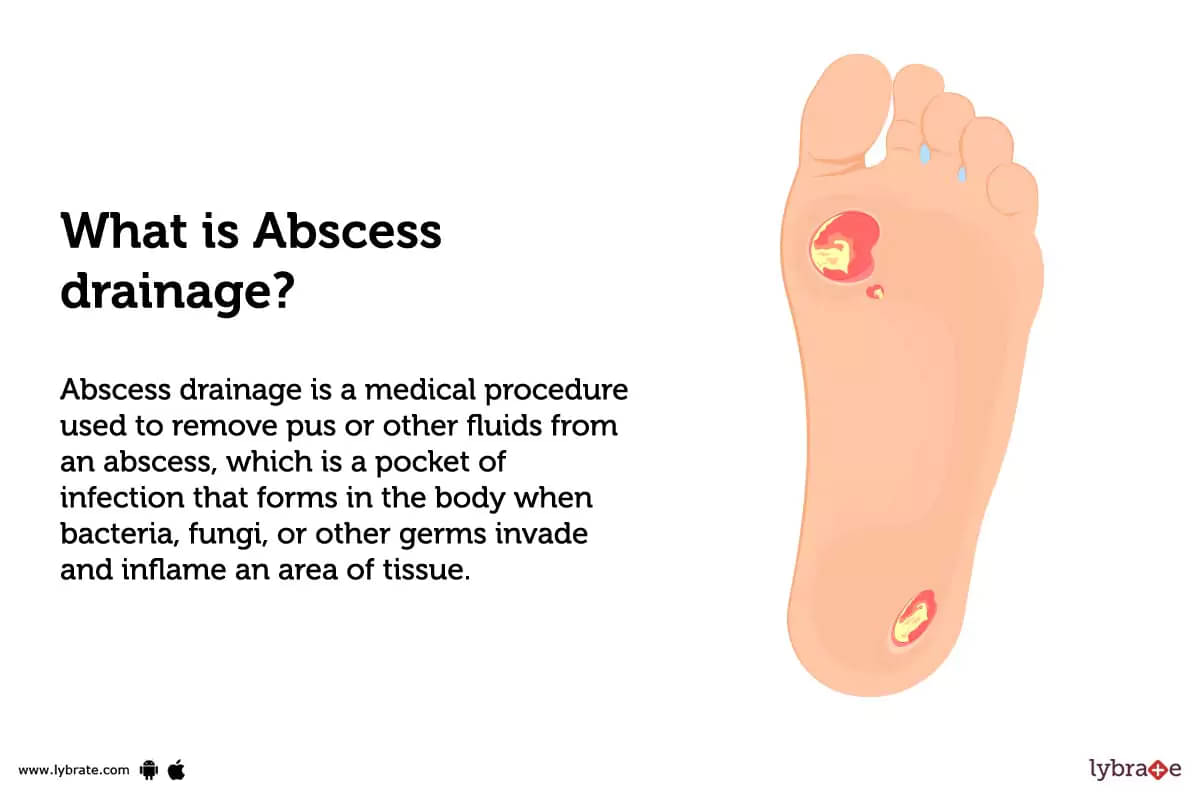Abscess Drainage: Causes, Symptoms, Treatment and Cost
Last Updated: Jul 04, 2023
What is Abscess drainage?
Abscess drainage is a medical procedure used to remove pus or other fluids from an abscess, which is a pocket of infection that forms in the body when bacteria, fungi, or other germs invade and inflame an area of tissue. Abscess drainage involves making a small incision into the abscess and draining the infected fluid out of it. This helps reduce pain and swelling and allows antibiotics to reach the infection site more effectively.
Types of Abscess drainage:
- Incision and drainage: This is the most common type of abscess drainage. To enable the abscess to drain, it entails creating a little incision in the skin above it.
- Needle aspiration: This procedure involves inserting a needle into the abscess and using suction to remove the pus.
- Catheter drainage: A catheter may be inserted into an abscess to help it drain more efficiently and reduce pain and discomfort associated with an abscess.
- Surgical excision: In some cases, surgical excision may be necessary if an abscess is very large or difficult to access with other methods of drainage.
Benefits of Abscess drainage:
Abscess drainage has many benefits, including:
- Relief of pain and discomfort: Abscesses can cause significant pain and discomfort due to inflammation of the affected area. By draining the abscess, the pressure on surrounding tissue is relieved, providing significant relief from pain and discomfort.
- Reduced risk of further infection: By removing the pus from an abscess, the risk of further infection or spread of bacteria is reduced significantly. This helps prevent further complications from developing as a result of the abscess.
- Improved healing time: The removal of pus from an abscess allows for improved healing time as it reduces inflammation and encourages healthy tissue growth in its place. This helps speed up recovery time for patients with an abscess.
- Reduced risk of organ damage: If left untreated, an abscess can spread into nearby organs or tissues which can cause permanent damage or even death in some cases if not treated quickly enough. By draining the abscess quickly, this risk is significantly reduced as it prevents bacteria from spreading into other areas of the body.
Why is Abscess drainage done?
Abscess drainage is done to help relieve pain and pressure, reduce the risk of infection spreading, and promote healing.In order to effectively treat an abscess, it may also be used to help determine its cause.
What are the risks of Abscess drainage?
The risks associated with abscess drainage include:
- Infection: If the abscess is not properly drained, it can lead to further infection and spread of bacteria.
- Bleeding: Draining an abscess can cause some bleeding, especially if the area is tender or inflamed.
- Scarring: The drainage site may leave a scar after healing.
- Allergic reaction: The antibiotics prescribed for abscess treatment might cause an allergic response in some persons.
- Pain: The area around the abscess may be painful during and after draining it.
How do I prepare for Abscess drainage?
- You should discuss any queries or worries you may have with your doctor prior to having an abscess drain. Recommendations on how to be ready for the surgery and any required preoperative exams will most likely be given by your doctor.
- It's crucial that you adhere to your doctor's pre-operative guidelines. This can include taking antibiotics, refraining from taking certain drugs, or fasting for a predetermined amount of time before the treatment.
- Additionally, it is important to wear loose clothing and avoid wearing jewelry or makeup on the day of the procedure.
- Since anaesthetic may be used during the draining process, you should also make arrangements for someone to transport you home following the treatment.
How Abscess drainage is done?
The procedure for abscess drainage involves making a small incision in the skin over the abscess, using either a scalpel or needle. A small amount of pus will be expressed from the incision, and then suction may be used to remove additional pus. The area may then be irrigated with a sterile saline solution to help flush out any remaining debris or bacteria. Lastly, a dressing may be used to help with wound care and infection prevention.
Abscess drainage is typically done as an outpatient procedure under local anesthesia. Depending on the size and location of the abscess, it may take several visits for all of the pus to be drained completely. Afterward, antibiotics may be prescribed to help fight any remaining infection and promote healing.
Steps to perform Before the procedure
- Get the patient's informed permission by outlining the process.
- Prepare the patient for the procedure by washing and disinfecting the affected area.
- To numb the region around the abscess, use local anaesthetic.
- Place sterile drapes around the affected area to maintain a sterile field during drainage of abscess contents.
Steps to perform During procedure
- Insert a needle into the center of abscess and aspirate any pus or fluid present in it with a syringe attached to it.
- After aspiration, insert a small catheter into the abscess and attach it to a drainage bag or bulb so that any further drainage can occur slowly over time while healing occurs at same time .
- Remove any remaining debris from inside of abscess with forceps or tweezers if necessary.
Steps of perform After the procedure
- Apply an antiseptic solution to the region to clean it.
- Put a clean dressing on the wound area.
- Keep an eye out for infection symptoms including pain, swelling, and redness at the discharge site.
- To aid in the prevention of infection and to speed the healing process, take antibiotics as directed by your doctor.
How much does Abscess drainage cost in India?
The cost of abscess drainage in India can vary greatly depending on the type and size of the abscess, as well as the facility where it is being treated. Generally, the cost of an abscess drainage procedure can range from Rs.500 to Rs.5000 or more.
What to eat after Abscess drainage?
It is important to eat a healthy and balanced diet after having an abscess drained. Protein-rich, vitamin- and mineral-rich foods may aid in the body's repair and recovery. Lean meats, fish, eggs, fruits, vegetables, whole grains, nuts, and seeds are a few examples of things to consume. In order to keep hydrated, it's also critical to consume a lot of liquids, such as water or herbal tea.
Is Abscess drainage safe?
Draining an abscess is often seen as a safe technique. It is a common and effective way to treat abscesses, as it allows the infection to drain and heal. The risks of abscess drainage are typically minimal, but may include pain, bleeding, infection, or scarring.
Is Abscess drainage painful?
Yes, abscess drainage can be painful. The physical process of draining the abscess and the pressure created by the fluid within it are often what produce the pain. Any discomfort brought on by abscess drainage may be managed with the use of painkillers.
How long does it take to recover from Abscess drainage?
Depending on the size and severity of the abscess, healing time after drainage may vary. The time it takes for the region to totally recover might range from a few days to a few weeks. In certain circumstances, further treatments may be required to stop the abscess from recurring or becoming infected.
What are the side effects of Abscess drainage?
Pain, swelling, bleeding, and bruising at the incision site are the most typical negative effects of abscess drainage.
Other potential side effects include infection, allergic reactions to medications or anesthesia used during the procedure, and temporary nerve damage.Rarely, if air gets into a vein or artery while the surgery is being done, it might result in an air embolism.
Abscess drainage Aftercare:
Aftercare for abscess drainage includes:
- Keeping the area clean and dry.
- Using a warm compress multiple times each day to reduce the discomfort and swelling.
- Using an antibiotic as directed by your doctor to aid with infection prevention and speed recovery
- Changing the bandage regularly to keep the wound clean and dry, or as instructed by your doctor or nurse practitioner.
- Avoiding activities that could irritate or infect the wound, such as swimming or soaking in a hot tub until it has healed completely.
- Informing your doctor if you suffer any infection-related symptoms, such as fever, chills, redness, swelling, worsening pain, or pus leakage.
Conclusion:
Drainage is an important part of the treatment of abscesses, as it helps to reduce pain, decrease inflammation, and promote healing. When carried out by a qualified healthcare expert, the process is often secure and efficient. To achieve a positive result, it is crucial to adhere to all of the doctor's directions. With proper care and attention, abscess drainage can help patients achieve a full recovery from their condition.
Table of content
Find Dermatologist near me
Ask a free question
Get FREE multiple opinions from Doctors



